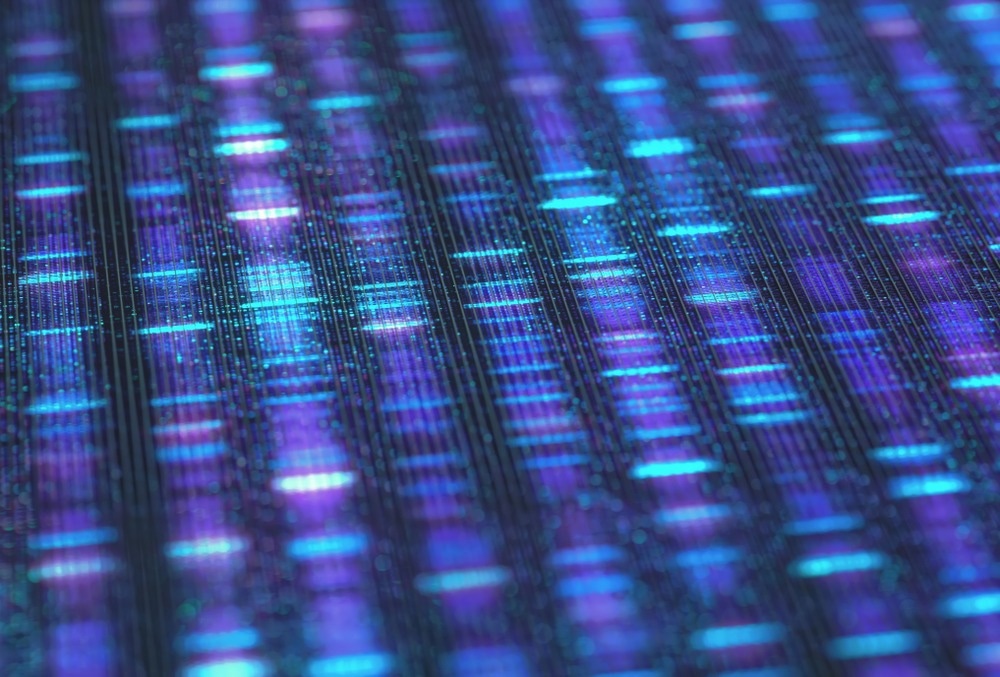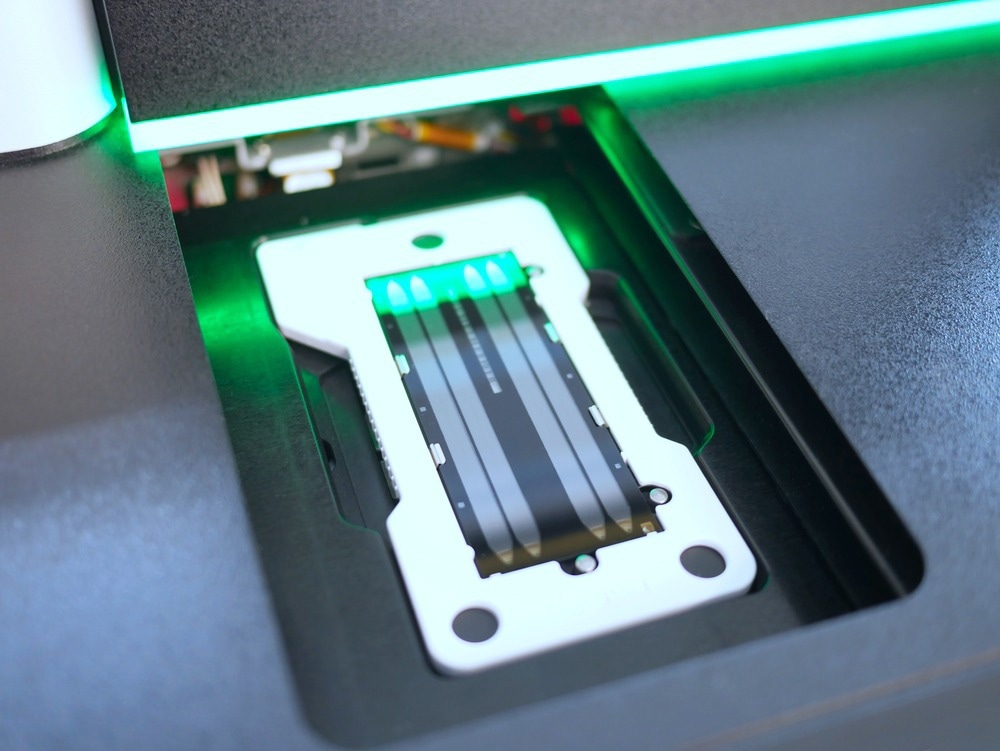Understanding the structure of DNA was one of the most important scientific discoveries made in the 20th century, as it gave us a vital foundation for understanding the secrets that lay within its intricate helical anatomy. Sequencing DNA was the next key step in this venture, whereby the technology that allowed us to peek into DNA’s delicate structural pattern has evolved substantially since its conception.

Image Credit: ktsdesign/Shutterstock.com
The Sanger Method
It was in 1980 that Frederick Sanger was awarded his second Nobel Prize in Chemistry for his development of the first DNA sequencing method, his first award being given in 1958 for his work on the structure of insulin.
Named the Sanger Method, the basic principles of this method for DNA sequencing involves in vitro DNA replication, with the use of DNA polymerase, oligonucleotide primers, deoxynucleotides, and the selective addition of radiolabelled dideoxynucleotideside triphosphates (ddNTPs) to terminate the replication process.
Replication termination of DNA strands is observed via polyacrylamide gel electrophoresis and allows for the identification of each nucleotide base through the radioactively labeled ddNTPs. It was this Sanger DNA sequencing method that paved the way for the Human Genome Project, a project that aimed to sequence every human chromosome within the cell for the first time.
Although the Sanger Method is still currently used today and is also considered the ‘gold standard’ of DNA sequencing, providing a sequencing accuracy of 99.9%, there are still a few drawbacks. Such disadvantages are low throughput, high cost, and being a time-consuming process.
The Sanger method was improved by shotgun sequencing, which was developed to allow for more rapid sequencing. In this technique, DNA is broken up into short-read fragments and sequenced in parallel, with overlaps, making it a much faster technique than long-read sequencing.
Further development from the Sanger Method arrived with the direct blotting electrophoresis system GATC1500, which did not require radioactive labeling, in 1985 by Fritz Pohl. In 1987 at Applied Biosystems, further improvements were made by Leroy Hood and Michael Hunkapiller, where they successfully automated the Sanger Method, using fluorescent dyes and the ability to process data via a computer.
Next Generation Sequencing
Thus far, the mentioned sequencing technologies are known as the first generation of DNA sequencing, and what would be developed thereafter are known as next generation sequencing (NGS). A distinguishing feature of NGS is the ability for high-throughput sequencing of DNA by sequencing millions of DNA fragments in parallel, therefore enabling the sequencing of entire genomes in one day, a feat that has truly revolutionized genome sequencing and driven the genomic revolution.
Setting off the NGS technologies is a novel DNA sequencing technique that abandons the need for fluorescently or radioactively labeling nucleotides and oligonucleotides, known as pyrosequencing. In this DNA sequencing, technological advance luminescence is produced, with the presence of luciferase, as a by-product of pyrophosphate synthesis during the sequencing process. In this automated process, a pyrogram is produced whereby the light luminescence is detected and measured, thus allowing the identification of the sequencing pattern.

Image Credit: Elpisterra/Shutterstock.com
Pyrosequencing is also called sequencing-by-synthesis, in which another sequencing technology based on this principle has also been developed. One such development is the use of fluorescent dyes created by the biotechnology Solexa in 1997, now acquired by Illumina, hence known as Illumina dye sequencing.
Another NGS technological development is sequencing-by-ligation (SBL). SBL involves using the enzyme DNA ligase to produce sequencing strands of DNA, as opposed to DNA polymerase seen in previously mentioned sequencing techniques. This method relies on using fluorescently labeled pools of differing lengths of oligonucleotide probes, whereby the fluorescent label is relevant to the nucleotide to be identified.
NGS technology also expands to utilize the charge of ions during the sequencing process, and thus named ion semiconductor sequencing. This method is similar to the pyrosequencing method mentioned above, whereby instead of a pyrophosphate being measured, here it is hydrogen cations that are measured as they are released and detected by an ultrasensitive pH meter during nucleotide addition.
Small Molecule Real-Time (SMRT) Sequencing
Although the sequencing technologies discussed already provide faster and more cost-effective ways to sequence DNA compared to the Sanger method, it was not until the advent of Small-Molecule Real-Time (SMRT) sequencing that allows for real-time DNA sequencing and dispensing the need for polymerase chain reaction (PCR) DNA amplification, which is required in some of the methods discussed above – such as pyrosequencing and ion semiconductor sequencing.
SMRT sequencing technology involves nanostructures that guide light energy, known as zero-mode waveguides, to allow single molecule studies, which involve high concentrations of fluorescently tagged molecules. Light energy is released as DNA polymerase is actively sequencing, that is, with the addition of each nucleotide base, and real-time measurement of fluorescent light is observed and recorded. The beauty of this sequencing method is allowing long read sequencing at high speed, harnessing the power of DNA polymerase, and therefore a very efficient way to sequence.
SMRT sequencing technology has been developed further to what is now known as nanopore sequencing, developed by Oxford Nanopore Technologies. This sequencing technology utilizes a nanopore embedded within a lipid membrane, whereby single-stranded DNA is then threaded through the pore, and a current is produced. With the use of detectors, changes in the current are measured, giving the identity of the nucleotide in real-time. One great leap in this advance is the portability of the device that carries this technology, known as the Oxford nanopore MinION sequencer.
Conclusion
Gene sequencing has come a long way since the Sanger sequencing method, with the ability to now sequence whole genomes in a single day and produce data in real-time. These advancements in genome sequencing will touch many areas in our society, such as paving the way for personalized medicine and even finding its way into our justice system in convicting, truly ushering in the genomic revolution.
Sources:
- Shampo M, Kyle R. Frederick Sanger—Winner of 2 Nobel Prizes. Mayo Clinic Proceedings. 2002;77(3):212.
- Jamuar S, D'Gama A, Walsh C. Somatic Mosaicism and Neurological Diseases. Genomics, Circuits, and Pathways in Clinical Neuropsychiatry. 2016:179-199.
- Gomes A, Korf B. Genetic Testing Techniques. Pediatric Cancer Genetics. 2018;:47-64.
- [Internet]. 2022 [cited 02 July 2022]. Available from: www.thermofisher.com/.../
- Behjati S, Tarpey P. What is next generation sequencing?. The BMJ. 2022.
- Bharagava R, Purchase D, Saxena G, Mulla S. Applications of Metagenomics in Microbial Bioremediation of Pollutants. Microbial Diversity in the Genomic Era. 2019:459-477.
- Pereira D, Fernandes J, Valentão P, Andrade P. “Omics” Technologies. Principles of Translational Science in Medicine. 2015;:25-39.
- Chang F, Liu G, Liu C, Li M. Somatic Diseases (Cancer). Clinical Genomics. 2015:297-319.
- Korlach J, Turner S. Zero-Mode Waveguides. Encyclopedia of Biophysics. 2013;:2793-2795.
- Wang Y, Zhao Y, Bollas A, Wang Y, Au K. Nanopore sequencing technology, bioinformatics and applications. Nature Biotechnology. 2021;39(11):1348-1365.
Further Reading
Last Updated: Sep 15, 2022